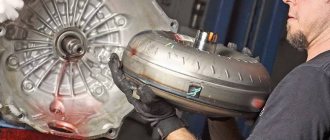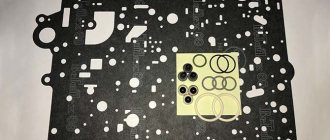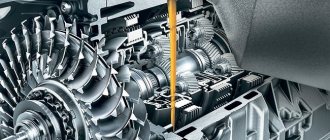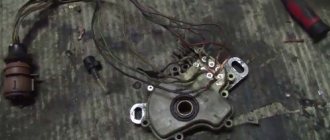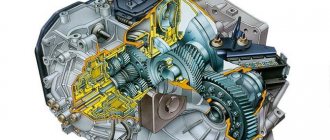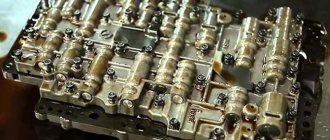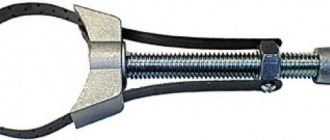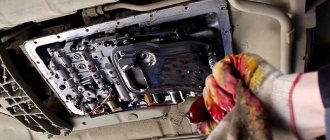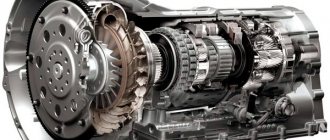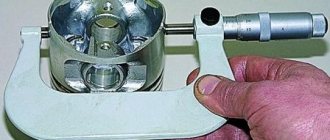Malfunctions of the torque converter and its blocking
Having considered what the operation of the gas turbine engine is based on and how the torque converter is blocked, it is not difficult to guess that the presence of friction linings (rubbing pairs) means a decrease in service life.
Moreover, these friction pairs actively wear out due to heavy loads and early locking. Also, their wear products contaminate the gas turbine engine itself from the inside; transmission oil is also subject to severe contamination. The result is active wear of all parts without exception, not only of the “donut” itself, but also of the automatic transmission. The first to suffer from the presence of abrasive in the oil are the turbine wheel blades and bearings, then the gaskets and rubber seals fail, then the dirty oil damages the automatic transmission valve body channels, solenoids, etc.
We also recommend reading the article about why the automatic transmission slips. From this article you will learn about the reasons why automatic transmission slips.
Simply put, the main source of ATF contamination in modern automatic machines is the torque converter. The worst thing is if the material of the locking friction linings is structurally glued to the base. This means that as a result of inevitable wear, not only abrasive, but also glue particles get into the oil. The adhesive base contaminates the oil even faster.
It becomes clear that the “donut” with worn-out locking elements needs to be changed or repaired, and in many cases already by 100-150 thousand km. Precisely because old automatic transmissions rarely had locking or did not have it initially, the oil change intervals were long, and the service life of the automatic transmission and gas turbine engine itself was also impressive. Unfortunately, this cannot be said about modern analogues.
What is a fluid coupling
Unlike a torque converter, a fluid coupling does not change engine torque, but transmits it directly to the transmission. Therefore, the design of a fluid coupling is simpler and includes: a housing, pump and turbine wheels rotating in an oil environment.
The unit is installed in transmissions of trucks, buses, tractors and agricultural machinery.
Signs of a fluid coupling malfunction
Since the fluid coupling is a “simplified version” of the torque converter, their malfunctions are similar:
- car slipping due to broken hub splines;
- metallic knock from a faulty bearing;
- leakage of liquid through worn seals, etc.
Like the torque converter, the fluid coupling suffers from overheating and contamination of the oil in the automatic transmission. If there is no pressure, the unit will not work properly, which means the machine will not move.
Fluid coupling repair
Repairing a fluid coupling is similar to restoring an automatic transmission donut. Due to the absence of a friction lining and a reactor, the cost of work and materials will be lower.
Device, principle of operation, modes
DIY xenon ignition unit repair.
Possible breakdowns. Replacing the block The design of the torque converter includes only a few elements:
- Pump wheel;
- Turbine wheel;
- Stator, also known as a reactor;
- Frame;
- Locking mechanism;
The torque converter is mounted on the engine flywheel, but one of its components has a rigid connection with the gearbox shaft.
If we compare this type of transmission with a conventional friction-type clutch, then the pump wheel acts as a drive disk (rigidly connected to the engine crankshaft), and the turbine wheel acts as a driven disk (attached to the gearbox shaft). But there is no physical contact between these wheels.
It is noteworthy that even the location of these wheels is identical to the friction clutch - the turbine wheel is located between the flywheel and the pump wheel.
All components of the torque converter are enclosed in a sealed housing filled with a special working fluid - ATF oil. Due to its shape, this transmission element received the popular name “donut”.
The essence of how a torque converter works is very simple. The wheels of the device have blades that redirect the liquid in a certain direction.
Rotating together with the flywheel, the pump wheel creates a fluid flow and directs it to the turbine blades, thereby ensuring the transmission of force.
If the design included only these two wheels, then the torque converter would be no different from a fluid coupling, in which the torque on both components is almost the same.
But the task of the torque converter is not only to transmit force, but also to change it.
So, at the start, it is necessary to ensure an increase in torque on the driven wheel (at the start of movement), and during uniform movement, to eliminate the so-called “slippage”.
To perform these functions, the design includes a reactor and a locking mechanism.
The reactor is another impeller, but of a much smaller diameter, and it is located between the turbine and the pump; the reactor is connected to the latter by means of an overrunning clutch.
The task of this element is to increase the speed of fluid flow, which leads to an increase in torque.
The reactor works like this: if there is a large difference between the main wheels of the torque converter, the overrunning clutch blocks the reactor, preventing it from rotating (because of this, another name for the component is the stator).
At the same time, its blades, which have a special shape, increase the speed of the fluid flow that hits it after passing the turbine wheel, and direct it back to the pump.
Thus, the reactor significantly increases the torque required to create sufficient force when starting to move.
With uniform movement, the torque converter is blocked, that is, a rigid connection appears in it, and this is done by the locking mechanism used in the design.
Previously, in automatic transmissions, this component only worked at high speeds. Now, the electronic transmission control systems used block the torque converter at almost all stages.
That is, as soon as the torque for a certain gear approaches the required parameters, the mechanism is activated.
When changing gears, it turns off to ensure smooth shifting and turns on again. This eliminates the possibility of the torque converter “slipping,” which increases its service life, reduces effort losses and reduces fuel consumption.
It is noteworthy that the locking mechanism is essentially a friction clutch, and it works on the same principle. That is, the design has a friction disk that is attached to the turbine.
When the locking mechanism is turned off, this disk is in a depressed state. When the lock is turned on, the clutches are pressed against the torque converter housing, thereby achieving rigid transmission of torque from the engine to the gearbox.
In general, if we consider the functioning of the torque converter, then there are three modes of its operation:
- Transformation (turns on when an increase in torque is required to create more force. The reactor operates in this mode, providing an increase in the flow speed);
- Fluid coupling (in this mode the reactor is not involved and the torque on the drive and driven wheels is almost the same);
- Blocking (the turbine is rigidly connected to the housing to reduce losses due to “slippage”).
The electronic system used to control the operation of the torque converter ensures a very quick change in its operating mode, adjusting the functioning of this element to the emerging conditions.
Torque converter slippage: why it happens and the main symptoms
So, the torque converter or automatic transmission fluid coupling is the clutch of an automatic transmission. Moreover, this device is very different from the usual mechanical clutch, which is installed on manual transmissions and a large number of robotic gearboxes with one clutch.
To make it clear, the principle of operation of a torque converter is that the torque converter housing is attached to the engine flywheel through a special adapter plate. The housing rotates together with the flywheel. By the way, the gas turbine engine itself is sealed; inside the automatic transmission “donut” housing there is ATF transmission fluid.
So, the flywheel spins a special pump wheel located inside the torque converter. As a result, the oil passes through the torque converter reactor, then enters the turbine (turbine wheel), causing it to rotate. The turbine transmits energy to the input shaft of the automatic transmission. As you can see, the torque converter plays the role of a clutch between the engine and the gearbox, but there is no rigid connection, since the energy is transmitted through the oil.
This solution makes it possible not only to transmit, but also to additionally convert torque from the engine, which allows optimizing effort, achieving soft shifting of automatic transmission gears, reducing vibrations, shock loads, etc. Also in modern gas turbine engines, torque converter locking is actively used.
Blocking the gas turbine engine is necessary to minimize losses that inevitably arise due to the lack of a rigid connection and transmission of torque through the liquid inside the torque converter. Also, the fact that the working fluid (ATF oil) gets very hot leads to a decrease in efficiency. In a nutshell, in certain modes, a mechanical lock is activated inside the gas turbine engine, which in its principle resembles a mechanical clutch.
Locking the donut allows torque to be transmitted from the engine directly rather than through liquid, which provides increased efficiency, better fuel economy, more intense vehicle acceleration, etc.
- As you can see, the structure of this element is quite complex, and the gas turbine engine also operates under load. It is quite obvious that breakdowns and premature wear often occur. Often, the first signs of a torque converter malfunction look like the car loses dynamics, responds worse to pressing the gas pedal, fuel consumption increases, etc.
An early sign of problems with the gas turbine engine is when the engine speed is slightly increased while driving, that is, for example, if normally in third gear and a speed of 60 km/h it was 2500 or 3000 rpm when driving on a flat road, then it became 3500 or more when driving in exactly the same conditions at the same speed (third gear, flat road, no additional load, etc.).
Also among the initial signs can be identified torque converter slippage (torque converter slippage). If the torque converter slips or slips, this manifests itself in such a way that, for example, when driving in a particular gear and accelerating in it, the engine speed does not increase smoothly, but increases sharply (jumps by 500-600 rpm and higher).
- More serious symptoms are that, in combination with the symptoms described above, when modes D or R are turned on, a hum or howl appears in the box area, and the noise disappears in mode N or P, and also intensifies with increasing engine speed while the car is moving. The driver may also notice that the gearbox shifts gears “hardly”, there are noticeable shocks, vibration has appeared, the engine speed fluctuates greatly when driving, etc.
If, for example, a car with an automatic transmission begins to accelerate poorly, the dynamics are lost and the gearbox is noisy, a common cause is a malfunction of the reactor overrunning clutch inside the gas turbine engine. You also need to pay attention to the symptom when, when you turn on R or D, the car does not move, and the driver presses on the gas and the engine speed clearly increases, but the engine turns a little “heavier” than when pressing the gas in neutral gear N.
In this case, there is a high probability that the torque converter turbine splines have been cut off. If the engine stalls when you turn on D on the automatic transmission or the engine speed drops or jumps, the problem may be related to the torque converter blocking. This malfunction on many cars is diagnosed by connecting a scanner.
If an error of the type “torque converter lock-up clutch, no torque transmission” is detected, this indicates that the torque converter is slipping. The reasons may be different, although often the culprit is the gas turbine engine blocking valve (solenoid), which “sticks” or does not work completely. In any case, such a malfunction leads to the fact that the locking does not work, torque is not transmitted directly, losses occur in the gas turbine engine, acceleration dynamics drop, etc.
Causes of automatic transmission malfunction
Possible gearbox malfunctions, their causes and solutions
The most common cause of automatic transmission breakdowns is non-compliance with vehicle operating rules. For example, the cause of a breakdown may be a sharp increase in speed or prolonged slipping in one place. In addition, driving at speeds above 150 km/h can significantly reduce the service life of the automatic transmission. But if you can’t imagine your life without racing, then change the oil in the box more often, because at high speed the oil quickly loses its properties. You should not tow another car, because this will lead to additional load on the automatic transmission components. In addition, the additional load always makes itself felt in snowy weather or when you drive through sand or mud.
Signs of automatic transmission failure
The smell and color of the oil can indicate that there is a malfunction in the automatic transmission. If the oil is black or dark brown in color, and there is a characteristic burning smell, this is a sure sign of a malfunction. Indicators of serious automatic transmission malfunctions include suspicious noise, jerking and a long time between gear shifts.
Automatic transmission overheating: consequences and signs
So, let us immediately note that a significant increase in the temperature of the transmission oil in an automatic transmission usually manifests itself in the form of certain malfunctions in the operation of the automatic transmission.
Ignoring such symptoms can lead to a reduction in the life of the unit itself or breakdowns. In other words, in this case, the automatic transmission often fails, after which an expensive overhaul or replacement of the transmission with a contract one is required.
- Let's move on. The reasons for overheating of the automatic transmission may be different. First of all, the unit itself contains a large number of loaded elements that interact with each other. As a result, a large amount of heat is generated, which is removed using ATF.
Another feature of many hydromechanical automatic transmissions is the high heating of the gearbox oil in the torque converter. This device is actually an automatic transmission clutch, while the torque from the internal combustion engine is transmitted through the transmission fluid.
It becomes clear that problems in the automatic transmission or gas turbine engine, deviation from the norm in the oil level in the automatic transmission, a decrease in ATF pressure, as well as loss of properties of the transmission fluid itself lead to an increase in the temperature of the automatic transmission. In some cases, the oil in the automatic transmission heats up to 120 degrees or more.
Such heating is critical, the oil loses its properties, the unit malfunctions, and gearbox wear increases significantly. The consequences of automatic transmission overheating manifest themselves in the form of breakdown of solenoids, friction discs, as well as a number of other gearbox elements.
In practice, after a couple of tens of minutes, operating the automatic transmission in maximum heating mode will be enough for the unit to fail. For this reason, it is important to promptly identify symptoms of automatic transmission overheating. In cases where the automatic transmission overheats, signs of excessive heating can be determined independently. If the automatic transmission is severely overheated, the transmission ECU can switch the unit to the automatic transmission emergency mode.
The check or A/T light on the dashboard indicates problems with the automatic transmission. Various automatic transmission sensors record an increase in temperature, a decrease in ATF pressure, etc. In such a situation, it is not uncommon for the torque converter to literally turn blue from strong heat, the automatic transmission wiring melts, and the clutches burn and crumble.
In this case, when the automatic transmission goes into emergency mode, it is optimal to immediately stop using the car and take it to the service center under your own power, so as not to further worsen the situation. Moreover, if you plan to tow without hanging the drive wheels, then you need to separately take into account all the rules and nuances of such towing a car with an automatic transmission.
- Please note that the machine will not always “fall” into an accident if it overheats. Often the box works, the check is not lit, but the temperature is approaching a critical level. In such a situation, after the automatic transmission reaches operating temperature, the driver usually feels obvious jerks, jolts during shifts, the automatic transmission slips, delays gear shifting, etc. At the same time, the box works fine when cold.
You need to understand that problems cannot be avoided in the future, since constant overheating, even if not critical, significantly reduces the life of clutches and solenoids, and can cause deformation of the valve body, etc. Under conditions of increased heating, the transmission oil itself also quickly loses its properties and becomes heavily contaminated. This means that the owner must constantly check the level and quality of the oil in the automatic transmission.
It is also important to note any changes in the operation of the unit and immediately carry out diagnostics, promptly change the automatic transmission oil and filter in the automatic transmission, and use high-quality fluids recommended by the transmission manufacturer itself.
Identifying the main faults of the automatic transmission torque converter
Automatic transmission for Jaguar S Type: design and operation
We list the signs of a faulty automatic transmission torque converter. As a rule, this installation loses its operating functions due to the natural wear of its components, for example, the clutch. The main manifestation of the fact that there is a breakdown with this element is the appearance of characteristic vibrations
In this case, the driver should pay special attention to the valve body valves
The presence of vibration is also evidence that the oil filter is clogged. With the replacement of this consumable, an oil change is also required. Checking the oil on each version of the car is individual. Thus, according to technological regulations, it can be carried out at 30,000, 45,000, 60,000 km.
It is necessary to pay attention to the integrity of the bearings if a characteristic sound begins to appear, which goes away when the speed increases. As a rule, disassembly of the torque converter is required
It is important to replace the automatic transmission torque converter oil seal after approximately 175,000 km. By this time, this consumable begins to leak due to a violation of its elasticity. Often, leaks occur not because the oil seal has lost its state of aggregation, but because the gearbox housing has become deformed.
The smell of melting plastic began to be felt inside the car. This is evidence that the torque converter is experiencing enormous loads, resulting in overheating. In this case, you need to check the amount of lubricant, oil level, and the cooling system of the speed box. There is no need to replace the automatic transmission torque converter.
Replacing the control unit is important if the automation fails. At the same time, when changing speeds, the engine stalls.
Torque converter repair and its component operations
Carrying out repair work to restore normal operation of this unit is impossible without dismantling the gearbox. It is worth noting that this is a rather labor-intensive procedure. Minimal repairs involve depressurization and disassembly of the unit after cutting the weld, cleaning all parts, troubleshooting them and replacing them if necessary, subsequent high-precision welding of the housing, checking for leaks and compliance with standards, and balancing.
The torque converter of an automatic variable transmission is repaired, even despite the long service life of the unit.
The safety of any trip directly depends on this. Therefore, repairs should be entrusted to professionals who have successfully specialized in such repair work for a long time.
Purpose
To clearly imagine what role the torque converter plays in an automatic transmission, it is worth remembering the purpose of an ordinary clutch, which is universally installed on manual transmissions.
The clutch acts as a link between the engine and transmission. In other words, if the clutch is not disengaged, then one hundred percent of the motor is transferred to the gearbox, and, consequently, to the wheels. In addition to everything, the manual transmission itself allows the driver to choose the gear himself and change the torque, which allows him to achieve maximum engine efficiency when driving and simply prevent it from stalling in place when the wheels are not rotated.
The main disadvantage of manual transmissions over automatic transmissions is that in addition to constantly selecting the speed manually, you need to depress the clutch pedal. If this is not done, there is a risk of damaging the extremely expensive clutch and burning it, which will lead to the need to replace it.
It was for these purposes that the transformer began to be used. This element is much more complex than the clutch on a manual transmission, which consists of only two discs - a drive and a driven.
Then the question arises: is it possible to use an ordinary clutch on an automatic transmission instead of a torque converter, as on a manual transmission? The answer is incredibly simple - the automatic transmission itself selects the moment when the gear needs to be changed, and the driver does not know this moment in advance. Consequently, there is no way to press the clutch pedal in time. Hence the need arises to introduce a torque converter into the automatic transmission, which greatly facilitates the interaction between the driver and the box.
Causes of automatic transmission donut failure
It happens that a breakdown of the torque converter completely disables the engine part of the car. The automatic transmission goes into emergency mode. Automation displays some errors on the on-board computer.
Read
Diagram, repair of automatic transmission 4F27E and valve body with your own hands
But since the “donut” is a partially autonomous mechanical system, most breakdowns are difficult to determine through a computer. You have to disassemble the automatic transmission to get to the torque converter and disassemble it. Only by sawing the “donut” in half can the fault be determined by visual inspection and repairs carried out.
There are three reasons for the failure:
- driver;
- manufacturer's defect;
- aging.
Let's consider each case of an automatic transmission being repaired.
The reason is the driver. Negligent attitude towards the car, in particular the gearbox. Doesn't monitor the quality of the oil. Bad oil overheats and damages the seals, which become thinner under the influence of high temperatures.
Doesn't bring the automatic transmission to the service center for maintenance on time. The blades of the pump wheel, turbine, and reactor wear out. Clutches burn out. The automatic transmission begins to howl and vibrate. If the driver does not pay attention to the symptoms, then he has to shell out good money to repair the donut.
The reason is a manufacturer's defect. Oil seals that have not passed the test or seals made from fragile, defective Teflon and plastic often cause oil leaks. This leads to oil starvation. The latter leads to starvation of the entire box, which negatively affects its operation. The donut needs repairs.
Couplings are rarely defective. During operation, such a device may slip or, on the contrary, be blocked earlier or later than the required moment. Its wear products get into the oil, clog the filter and valves in the valve body. The donut needs repairs.
The reason is aging. This is a natural cause of failure. Happens after three to five years of proper operation, if the driver monitored the automatic transmission, topped up and changed the oil regularly. The components gradually wear out and refuse to work properly. Discovered and replaced during the next donut repair pass during maintenance.
Automatic transmission torque converter repair
The gas turbine engine is a reliable unit and can operate for a long time without complaints. Its service life should coincide with the service life of the automatic transmission itself. However, it happens that this part is sent for urgent repair. The main failures that can befall your gas turbine engine are wear of parts such as the pump wheel hub, locking clutch, cracks or kinks in the wheel blades.
If you repair the automatic transmission torque converter in a timely manner, it will not cost much. A problem that is not corrected in time usually leads to the need to replace the entire gas turbine unit.
Since the automatic transmission torque converter and gearbox have a common fluid circulation, wear products of various parts affect the operation of the entire unit as a whole. Therefore, when planning engine and automatic transmission repairs, you also need to carry out a preventive inspection and check of the torque converter.
It is impossible to remove wear products, as well as inspect the integrity of the wheels of the gas turbine engine without depressurizing it. Therefore, after the body is cut, the repair continues by thoroughly washing the parts and examining them for wear: any cracks, chips, deformation or missing teeth on the wheels - all this requires immediate replacement of parts.
You can diagnose possible problems yourself, based on standard signs of automatic transmission torque converter breakdowns.
For example, if when you engage a gear you hear a slight rustling noise, which then disappears, then, most likely, the problem is the wear of the thrust bearing connecting the pump wheel and the reactor or the turbine bearing with the gas turbine engine cover.
If you hear a loud metallic knock when you engage the gear, then repairs may be needed for worn-out blades that have fallen out, become deformed, or chipped.
If aluminum powder settles on the oil dipstick, this indicates wear on the freewheel end washer.
The appearance of the smell of melted plastic indicates the need for urgent repair of the torque converter. When overheated, parts made of polymer materials failed.
If the engine begins to stall when changing gears, it means that the automatic transmission torque converter locking system has activated due to a failed control system. Well, stopping the car may mean that the splines on the turbine wheel have been cut off.
After replacing worn parts, the repair of the torque converter ends with the assembly and welding of the gas turbine housing. After welding, the body must be checked for tightness, correct fastening of all internal elements and their runout. Lastly, the internal thermal gap is checked for compliance and balancing is performed.
It is almost impossible to repair an automatic transmission torque converter efficiently and accurately at home. A poorly repaired gas turbine engine is just as dangerous as the one before the repair. It is better to repair your car by taking it to a specialized service center.
Donut repair and its cost
Repairing automatic transmission torque converters or CVTs with your own hands is problematic. You need knowledge about the operation of a specific donut model, a lathe, welding equipment, and stands for testing the assembled product. Repairs made by an inexperienced person can “kill” the hydraulic drive.
Find out exactly how much rub. Repairing the torque converter at a service center will cost you only after a full diagnosis, since the price is affected by:
- age and general condition of the car;
- automatic transmission brand and donut model;
- difficulty of torque converter failure.
Average prices for donut repair work:
| List of works | Price, rub |
| Removal and installation of automatic transmission | 12000 |
| Disassembling the torque converter | 800 |
| Assembly and testing on stands | 2000 |
| Pump wheel: | |
| Repair | 800 |
| Hub replacement/repair | 1000/600 |
| Turbine: | |
| Wheel repair | 500 |
| Hub replacement | 600 |
| Locking Clutch: | |
| Friction lining sticker | 400 |
| Locking system repair | 2000 |
| Reactor: | |
| Repair | 500 |
The cost of rebuilding a torque converter is affected by the complexity of the automatic transmission:
- for the repair of a donut 4, 5, 6-speed gearbox they will charge 5,000 - 10,000 rubles;
- for repairing a donut 8-speed gearbox - 10,000 - 15,000 rubles.
The most expensive torque converters to repair are installed in automatic machines:
- The most expensive torque converters to repair are installed in automatic machines:
4HP24;
- 5HP19;
- 6HP26;
- ZF6HP26/28/32;
- ZF8HP45/55/70;
- ZF9HP48;
- 722.9;
- 4R100;
- 6R80;
- A750F;
- TR60-SN;
- TR80-SD.
How the repair works:
- The craftsmen remove the box and dismantle the torque converter.
- Drain the liquid.
- The gas turbine engine is fixed on a lathe and the weld is cut.
- Clean parts from dirt manually or in a washing machine.
- The master examines the components of the donut and rejects the faulty ones. Parts are restored or replaced with new ones.
- On a special machine, a friction lining is glued onto the locking clutch.
- The next stage is assembling the unit with new consumables.
- The body is welded on a machine.
- Check the pump hub runout, bearing clearance, and tightness. Carry out balancing.
- Install the gas turbine engine and automatic transmission in place.
Correspondence of signs and causes
Here is a table of common automatic transmission breakdowns.
| Signs | Causes |
| Reverse gear does not work. Only speeds 1 and 2 function, but speeds 4 and 3 do not work. | The friction discs are worn out, the piston cuffs are broken, the sealing rings are destroyed. |
| The car does not move forward, it slips, reverse gear works. | Worn discs, front clutches, broken cuffs, worn clutch rings, stuck valve body. |
| The car does not move back and forth. Strong shocks when switching. | The torque converter is faulty; oil needs to be added and the filter needs to be replaced. |
| You can only drive in third gear. | Wear of friction discs, front clutches, breakage and wear of piston cups, wear of clutch rings, valve sticking. The electronic unit has switched the box into emergency mode; diagnostics and repairs are required. |
| Shifts on a cold box are made with jerks. | Dirty solenoids or hydraulic plates. Consumables need to be replaced and the valve body needs to be cleaned. |
| No reverse. | Worn brake band, broken cuffs, brake band, broken piston rod. |
| The car is unable to move in any direction. Switching is carried out without jolts. | Malfunction of the torque converter, pump drive gear, no gear engagement with the torque converter. It is necessary to add oil and clean the filter. Wear of the brake band, clutch and disc, as well as piston seals. Wear and breakage of O-rings. The valve body solenoid or valve is faulty. |
| The increasing rumble of the box, vibration when driving, intensify with increasing engine speed. | Bearing wear. |
| There is reverse gear, forward gears - only first and second. When the box warms up the problem goes away. | A dirty solenoid or valve body is stuck. |
| The car drives in neutral. | Incorrect adjustment of the gearbox lever or cable. Clutch piston jamming. Welding friction clutches. |
| Speeds are included at high speeds | Incorrect throttle cable adjustment, clogged filter, faulty throttle valve. |
| The car drives normally, but on an ascent the automatic transmission slips and switches to a reduced speed. | Low oil level, wear of friction discs, brake band. The oil pump and valve body solenoids are faulty. |
| A sudden press on the gas does not switch to a lower speed, and the kickdown does not work. | The button or sensor under the pedal is faulty, the switch valve is stuck, the damper cable is faulty, there is no power to the sensor. |
| When starting from a stop, it slips, but when the speed increases, it drives normally and the gearbox shifts properly. | Worn turbine wheel splines, broken cuffs. |
| When switching, slippage occurs. | The oil pump is faulty, the filter is clogged. |
| No forward or reverse. | The splines on the turbine wheel hub were cut off. |
| Significant shocks occur when changing speed. | Wear of the brake band, friction discs, clogged solenoids or valve body channels. |
| The car slips when driving and jerks when shifting. | Clutch failure. |
| No movement in both directions, no oil pressure. | Oil pump splines cut off. |
| The car moves normally until the oil warms up. Then slipping occurs and the car stops. | Faulty friction discs. When the oil is cold, its pressure and viscosity are higher compared to hot oil; worn discs are pressed better and form traction. Friction wear, oil contamination, filter mesh. |
| Noise in the form of metal beating at idle. | Severe wear on drum discs. |
| The transmission does not switch to a lower speed when the pedal is depressed, there is no kickdown. | Engine malfunction. |
| The transmission does not switch to a lower speed when the pedal is pressed all the way. The car moves normally until the oil warms up. Then the car slips and does not move. The car accelerates slowly. No reverse. | Violation of the tightness of the fan blades of the turbine and pump. Broken blades. |
| There are large metal shavings in the tray. | Severe wear on the planetary gear. |
| The oil in the box foams and slippage occurs. | Water penetration into automatic transmission. |
| Low oil pressure. | Dirty solenoids or valve body. It is necessary to check the oil level and the relief valve in the pump. |
| When the gear is engaged, the car stumbles and stalls. As the rpm increases it moves normally. | The speed clutch valve needs to be checked. The torque converter is faulty. |
| Aluminum shavings in a tray. | Wear of the plain bearing and planetary gear. |
| The tray contains plastic elements. | Broken plastic part. |
| Metal scraping. | Wear of differential bearing, gears. |
| Magnetized rollers were found in the automatic transmission tray. | Broken roller thrust bearing. |
Typical valve body malfunctions using the example of different automatic transmissions
The main causes of valve body malfunction requiring repair:
- contamination of channels with old dirty oil;
- scratches on the surface of the hydraulic plate and spools from metal shavings;
- weakening of springs, wear of seals, balls, filters;
- solenoids failure;
- overheated and dirty sensors;
- burnt electrical wiring.
The main contaminant of automatic transmission and CVT oil is the torque converter. Engaging the lock-up clutch in slip mode speeds up acceleration, but at the same time the fluid heats up faster and the clutch is more dirty. Dirt settles on the surface of the valve body channels and valves, making their operation difficult. Which channels become clogged most often depends on your computer settings and driving style. Repairs in the form of washing the plate and replacing the gaskets often solve problems with gear shifts.
The valve body undergoes serious repairs if the driver does not change the oil in the automatic transmission for 100,000 km, constantly slips in the snow, and subjects the car to “Off-Road” tests.
For the same reasons, the Mechatronics DSG is sent for repair:
- the valve body channels become clogged with dirt from the clutch basket;
- Overheated solenoids lose their characteristics, causing the computer to reject them, putting the box into emergency mode.
Using the example of different automatic transmissions, we can trace the similarity of the causes of valve body problems that require repair.
Jatco box
RE4F03B. Despite the reliability and unpretentiousness of the box, the valve body often gets repaired. The cause of the problems is clogged channels, worn seals, worn out solenoids. If you keep the oil clean and change the solenoid valves without waiting for them to die, then there will be no problems with the gearbox.
JR507A is installed in Infinity and Nissan cars with engines from 2.5 to 5.6 liters. Due to the acceleration of powerful engines, the clutch of the gas turbine engine is quickly eaten away, clogging the oil. A chain process occurs: contamination of the hydraulic plate in the automatic transmission, pressure drop, combustion of the clutches.
The bestseller among CVTs - Jatco JF011E - is installed in:
- Nissan Bluebira Syphy, Elgrad, Murano, Qashqai, Qazana, Sentra, Tiana, Tiida, X-Trail;
- Mitsubishi CX, Delica, Lancer, Outlander;
- Renault Megane, Koleos.
When used correctly, the machine does not cause problems and runs up to 100,000 km without repair. The stepper motors that regulate the variator gear ratio break due to overheating and exhaustion of their service life. The set of solenoids is also often replaced.
BTR boxes
BTR M741LE was installed on 2.0 - 3.2 liter SsangYong Rexton, Action, Korando engines. The M741LE valve body is problem-free. During major repairs, the standard procedure for flushing and cleaning the channels is performed. Rarely found in replacement.
BTR DSI-6 M11 has been found on SsangYong New Action, Rexton, Kyron since 2010. The valve body of this box is designed in the likeness of the Hyundai A6MF automatic, and the solenoids are borrowed from Borg Warner and GM. During scheduled repairs, gaskets and finely tuned solenoid valves are replaced in the valve body, which operate reliably for the first 100,000 km. Malfunctioning solenoids are diagnosed only through the equipment, and not through error codes.
Automatic transmission U140/U241E
4-speed Aisin U140E/U241E gearboxes are installed in tandem with 2.0 - 3.0 liter engines in:
- Lexus RX, ES250;
- Toyota Caldina, Camry, Corolla, Highlander, Rav4.
The design of the boxes is reliable and unpretentious. An automatic transmission lasts 100,000 km with one repair. Electrics are hassle-free and do not require expensive replacements. Usually, flushing the valve body and solenoids is sufficient. Aged hydraulic plates are cleaned of carbon deposits and the spool channels are restored.
The torque converter consists of the following parts
- pump (pump wheel);
- reactor;
- turbine (turbine wheel);
- overrunning clutch.
How does a torque converter work?
The pump must be connected to the engine crankshaft, while the turbine is connected to the gearbox shaft. The freewheel reactor rotates in the fluid flow when switching to fluid coupling mode. While driving, the torque converter experiences hydraulic and thermal stress. A special radiator cools the working fluid. If it is faulty, coolant may enter the transmission.
In what cases is torque converter repair necessary?
The most common reason is wear of the locking clutch. There are cases when repair of automatic transmission torque converters (repair of gas turbine engines) is necessary due to wear of the pump wheel hub or breakage of wheel blades. Other options are rare.
When repairing torque converters, the equipment must be cut, faulty and worn parts must be replaced. After this, the torque converter is welded again. Repair of automatic transmission torque converters (repair of gas turbine engines) cannot be carried out without opening the housing.
Repair of torque converters is carried out as an independent troubleshooting or as part of a comprehensive automatic transmission repair. Since the torque converter is subjected to significant thermal loads during operation, its parts wear out prematurely.
Malfunctions that the torque converter is susceptible to:
- unlocking the overrunning clutch;
- wear of the locking clutch;
- breakdown of wheel blades;
- overrunning clutch jamming;
- wear of the pump wheel hub.
Timely repair of automatic transmission torque converters allows you to extend the service life of the units. Do not delay repairing the gas turbine engine if there is the slightest sign of malfunction (jerks when shifting gears, vibrations)
Your attention to your car will help you avoid such an unpleasant extreme as replacing the torque converter. If minor problems are not corrected on time, not only torque converters will be required to be repaired, but also other parts.
Remember that repairing a donut will cost you less than replacing a torque converter. Car service center Lider Motors, carrying out repairs of automatic transmission torque converters, performs troubleshooting and replacement of failed parts. To disassemble the unit, it is necessary to cut the weld seam. Replacement of parts is possible only after depressurization. Repairing the donut also includes welding the body, checking for leaks and balancing.
Often the torque converter needs to be cleaned of automatic transmission wear products. In this case, the torque converter must also be opened. Whenever the torque converter is opened, the seals and O-rings must be replaced.
Torque converter repair is an important part of automatic transmission repair work. The consequence of their close relationship is that the failure of one node leads to the failure of another
Therefore, diagnostics of the gas turbine engine followed by repair, if necessary, is an integral part of automatic transmission diagnostics.
At the Lider Motors car service center, torque converter repairs are carried out using high-quality specialized equipment. A complete repair of torque converters can be carried out in a short time.
Our craftsmen guarantee that the restoration of torque converters (repair of gas turbine engines) will be performed flawlessly. They know well how specific the torque converter is, and therefore, accurately identifying problems, they quickly eliminate them.
Unfortunately, there are situations when repairing a gas turbine engine does not make sense. In such cases you will have to buy a torque converter
Please note that the sale of gas turbine engines is also included in the range of our services. From us you can buy a torque converter for all types of automatic transmissions serviced by our service center. Replacing the torque converter should also be carried out by professionals
So, if you need qualified torque converter repair or other services related to this unit, we are waiting for you.
Do-it-yourself torque converter diagnostics
The sequence for diagnosing an automatic transmission donut with your own hands:
Read
Basic malfunctions and repairs of Mazda 3 automatic transmission
| Degree of troubleshooting | What to do | When will it help? |
| Easy. Diagnosis can be made without tests | Check level, change ATF and filter | · the appearance of jerks or delays when changing gears; · slight vibration at speeds of 60-80 km/h; · dirty oil; · incorrect fluid level; Bubbles on the dipstick. |
| Average. Diagnosis can be made without dismantling | Clear fault codes from the on-board computer | · faulty wires, solenoids; · sensor malfunction; · problems with the locking clutch; · breakdown of parts. |
| Remove and inspect the pan for metal and plastic particles and sediment | ||
| Check system pressure | ||
| Test the blocking of the gas turbine engine: as the engine speed increases, the speed should increase | ||
| Heavy. An autopsy is necessary for an accurate diagnosis. | Disassemble the donut | · the oil smells like burning and contains large particles; · strong vibrations and knocking; · oil leak; · rattling, grinding; · the car does not move or is slipping. |
Most often, a torque converter needs to be repaired due to baldness of the lock-up clutch or aging of the seals. In this case, you have to additionally flush the valve body, change clogged solenoids, and worn out friction discs. Such service repairs are not cheap, but they will help prolong the operation of the original automatic transmission.
Typical torque converter malfunctions
Having examined the principle of operation of the torque converter, everyone could understand that this mechanism is loaded only when the car accelerates to a certain speed. At these moments, the hydromechanical device consumes the energy received from the motor to spin the control blades, thereby reducing the efficiency of its operation to 80-85%. It is at this moment of operation that the torque converter elements experience enormous loads and quickly wear out.
Conventionally, breakdowns of the hydromechanical mechanism can be divided into two large groups:
- Wear and failure of the components of the torque converter itself;
- Malfunctions of the hydraulic block plate in contact with it.
It is worth noting that the torque converter, unlike the valve body, is a non-separable unit and, accordingly, cannot be repaired. Despite this, in the auto repair industry it is common to simply cut off the weld seam connecting the two halves of the mechanism, repair it and re-weld it. Often one of the following malfunctions occurs with the torque converter:
- Wear of friction clutches;
- Looseness or wear of input and output shafts;
- Clogging or wear of the oil supply channels, which causes overheating of the device.
In addition, the valve body is important in the operation of the entire automatic transmission, in particular in the operation of the torque converter. The hydraulic plate most often has breakdowns of the following types:
- Clogged hydraulic filter or oil supply channels;
- Malfunctions of solenoids and sensors responsible for supplying lubricant to the torque converter;
- Incorrect operation of the oil pump.
Any malfunction of the automatic transmission torque converter and valve body manifests itself in the form of three main symptoms: overheating of these components, vibration and incorrect operation of the box. The appearance of such signs requires the motorist to take some measures, since speed is important when repairing a quickly killed machine, and you cannot hesitate when organizing it.
Repair process
So, let's start with what you need. The minimum list of tools is as follows:
- a set of wrenches, hexagons, screwdrivers and sockets;
- removable mechanism for removing a heavy box;
- overpass or lift;
- devices for washing the box;
- standard automatic transmission repair kit (kits should be purchased only after complete disassembly of the unit, otherwise they will not be needed);
- transmission fluid;
- rags and small auxiliary tools similar to containers for draining old oil.
Direct repair of the automatic transmission is carried out in the following order:
- We will first organize the check noted above;
- Then we carry out a complete oil change and flush the automatic transmission, after which we check its performance. No changes? Go ahead;
- Based on our feelings, indicators of sensors and on-board computer, we eliminate all malfunctions of the box that do not require its removal, of course, if there are any;
- Let's say the situation remains the same - the automatic transmission turns on and does not work correctly. This means we remove the unit from the car and disassemble it. We find faulty elements, replace them and be sure to re-rinse the box with gasoline and blow out the channels with compressed air. In addition, it is necessary to replace all consumables (automatic transmission gaskets, some seals and solenoids);
- Having repaired the unit, we assemble it and install it back on the car. Fill in the required amount of oil and run for 4-7 days. If the automatic transmission you repaired yourself is still not working correctly, then there is nothing to do - go to the professionals.
Repair and restoration work
You should entrust the repair of a torque converter breakdown to mechanics who work in a professional service center. They will help not only with disassembling the torque converter, but also with its assembly, which requires welding. Finally, the restored device is checked for leaks.
Replacing the torque converter must take place in specially created conditions. Professional equipment for repairing torque converters is available only at trusted stations. In particular, it is imperative to use an automatic machine that can carry out welding work when a torque converter repair is needed. You should not delay repairs if the torque converter is slipping.
When repairing a torque converter with your own hands, this device must be removed from its original location. It requires washing and troubleshooting. A special solvent should be used as a detergent. In this case, the car owner must not only have relevant experience, but also have special tools and work equipment. It should be noted that independent repair of a torque converter may involve replacing oil seals, bushings, and friction linings.
The design and principle of operation of the torque converter
The first such mechanism appeared in 1902 and 5 years later it was installed in the design of a high-speed vessel. Later, namely in 1928, the fluid coupling was successfully built into the transmission of a bus, and then into a car. General Motors and Chrysler companies, from 1945 to 1980, qualitatively improved the design of the fluid coupling, which provoked the emergence of a unit with a new name - the torque converter. It was this mechanism that began to be equipped with all automatic transmissions produced, and engineers worked only to improve it.
The torque converter of an automatic transmission is an analogue of the clutch of a manual transmission, which operates in automatic mode. Today, this hydromechanical device performs three main functions:
- The first one transmits rotation from the engine shaft to the automatic transmission mechanism;
- The second one softens the transmission of rotation to the level in which the gearbox is able to accept it without problems (that is, the torque converter protects the machine during sharp decreases and increases in the speed of the running engine);
- And the third - normalizes the supply of rotational motion to the box during acceleration (this is necessary in order to “dampen” the double increase in rotation transmitted from the motor to subsequent shafts).
Modern automatic transmission torque converters may be considered separate units from the planetary gearset (box), but they will not be able to work independently without it. This is due to the fact that this mechanism and the automatic transmission valve body (hydraulic plate) are inextricably linked. Their connection, by the way, is very simple - the second transmits the required amount of transmission fluid to the first, without which the operation of the torque converter is simply impossible.
The design of the device is also not particularly complicated and is a mill, some of the blades of which rotate due to the connection with the engine, and the others regulate the rotation using the hydraulic oil pressure available in the mechanism. The operation of the torque converter is important for the box only at vehicle speeds of up to 60-80 km/h, therefore, when this speed is reached, all the blades of the mechanism are locked into a single unit, after which rotation is transmitted directly to the box. Note that it is in locking the torque converter that the automatic transmission valve body plays an important role, therefore the functioning of these elements of the machine cannot be separated.
What is an automatic transmission torque converter?
In the slang of car owners and experienced mechanics, this device is called a donut. The nickname appeared due to the similarity of the torque converter to a bread product in appearance. To understand how important this device is in an automatic transmission, you need to understand the operating principle of the torque converter and look at its structure from the inside.
Some car owners call it a fluid coupling. This name is closer to it and lies in the field of mechanics. This occurs due to the fact that the gas turbine engine connects the engine and automatic transmission, acting as a clutch.
Only two automatic transmissions support the presence of a torque converter. This:
- automatic type or standard automatic;
- CVT type gearbox or CVT.
Gas turbine device
A torque converter is a complex device. Faults in any of its components can lead to the fact that the car either does not move at all or cannot accelerate.
It changes and transmits torque to the vehicle engine. Consists of the following elements:
- a pump wheel that creates a flow of lubricant. The oil flows and creates pressure, causing the following elements to rotate;
- the turbine rotates due to the flow of oil created by the pump wheel;
- reactor wheel, operating principle is identical to the turbine;
- freewheel or overrunning clutch;
- locking clutch.
The gas turbine engine is located between the engine and transmission in a compartment completely filled with transmission fluid. Oil not only acts as a lubricant, but also becomes a “wet” clutch.
Gas turbine malfunctions negatively affect the following automatic transmission components:
- oil pump;
- hydraulic unit;
- reduce the lifespan of the entire gearbox.
The lock-up clutch plays an important role in the operation of the torque converter. The lock improves the vehicle's fuel efficiency.
Blocking
When the blocking occurs is determined by the electronic control unit of the automatic transmission. And the principle of its operation is to slow down the car and reduce the rotation speed of the torque converter. Thus, torque is transmitted directly from the engine to the box. This happens until the gear changes again.
The locking clutch consists of:
- pistons with sealing rings;
- covers;
- the hub, which is connected to the wheel and shaft;
- two driving discs made of steel;
- three driven disks made of cermet.
The discs are connected in one housing, which are in tandem with a pump wheel on one side and a cover on the other.
Attention! Partial locking can be activated at a speed of 20 kilometers per hour on modern cars.
The torque converter lock-up clutch has disadvantages:
- when the torque converter is blocked, the driver can feel these shocks or jolts (using the example of unfinished features of the DP0 box from the French concern Peugeot-Citroen);
- smoothness decreases;
- The friction disc wears out quickly, the lubricant becomes dirty and loses its properties.
The positive aspects of blocking are that the amount of fuel consumed by the vehicle is reduced.
Principle of operation
The torque converter can operate in three modes.
Additional functions of the torque converter:
- protects the automatic transmission from the occurrence of malfunctions during acceleration and during sudden braking. This role is performed by ATF and damper;
- increases rotation. During acceleration, the torque doubles and the speed on the output shaft decreases.
Attention! All work of the hydraulic transformer is assigned by the ECU. It receives and sends signals to sensors. If a malfunction occurs in the automatic transmission torque converter, corresponding messages will appear on the dashboard.
